Posts Tagged voting
Indigenous Peoples’ Day

Poster, "Together, We Are Power," 2020 / THF626365
In honor of Indigenous Peoples’ Day, The Henry Ford would like to share our recent acquisition of two posters. Designed by artist Mer Young for the Amplifier Foundation in partnership with Nia Tero and IllumiNative, these graphics were created in support of a land stewardship campaign and timed to drive participation of the Native American vote during the 2020 presidential election.
Mer Young (Hidalgo Otomi and Mescalero-Chiricahau Apache) is an artist focusing on narratives that “inspire, celebrate and elevate repressed indigenous, first nations and native cultures and women of color” as well as issues related to immigration rights, equality, and the Black Lives Matter movement. These posters use digital collage techniques and were designed to be activated with augmented reality.
Poster, "Vote in Solidarity," 2020 / THF626361
In 1992, Indigenous Peoples’ Day was officially adopted in Berkeley, California, as an alternative to Columbus Day. Cities across the country have since adopted the holiday, including several in Michigan. This counter-celebration addresses the controversy over the “discovery” of the Americas by Christopher Columbus—and the suffering of First Peoples under the violence of European colonization and settlement that followed. Indigenous Peoples’ Day is a way to express solidarity and acknowledge this history while celebrating Native American history, culture, and communities.
For culturally sensitive activities and resources for Indigenous Peoples’ Day, check out “Unlearning Columbus Day Myths” from the Smithsonian National Museum of the American Indian.
Kristen Gallerneaux (Métis-Wendat) is Curator of Communications & Information Technology at The Henry Ford.
21st century, 2020s, Indigenous peoples, voting, technology, posters, by Kristen Gallerneaux, art
Celebrating Women at the Wheel at the 2021 Old Car Festival

“Women at the Wheel,” like the duster-clad driver at the controls of this 1907 Cadillac Model K, were spotlighted at this year’s Old Car Festival.
After a longer-than-usual pause, Old Car Festival returned to Greenfield Village on September 11–12, 2021. Our celebration of early American motoring included more than 700 registered cars, trucks, motorcycles, and bicycles dating from the 1890s to 1932.
Each year we shine our spotlight on a particular make, model, or theme. For 2021, we celebrated “women at the wheel” in commemoration of the 101st anniversary of the ratification of the 19th Amendment, which gave American women the right to vote. The automobile played a significant part in the fight for women’s suffrage. Cars expanded the range and reach of suffragists, allowing them to spread their message to smaller villages and hamlets located away from railroads. The automobile also provided a prominent mobile platform on which to hang signs and banners, and a traveling stage from which to make speeches and calls to action.
Ford Motor Company advertisements promoted the Model T as a source of freedom for American women.
From the start, automakers appealed specifically to women with targeted advertisements and booklets. Makers of early electric cars made a special point of advertising to well-to-do female buyers. Unlike early gasoline cars, electrics were clean, quiet, and required no crank starting or gear shifting. But many women weren’t bothered in the least by the gasoline car’s disadvantages. Alice Huyler Ramsey drove a gas-powered Maxwell across the United States in 1909, becoming the first woman to make the coast-to-coast road trip.
This 1912 Baker Electric was used by five First Ladies of the United States. / THF67884
We celebrated women at the wheel with a very special 1912 Baker Electric Victoria. It was purchased for use at the White House by President William Howard Taft and driven by First Lady Helen Taft. When the Tafts left, the Baker stayed behind and was used by four subsequent First Ladies: Ellen Wilson, Edith Wilson, Florence Harding, and Grace Coolidge. The Baker was retired in 1928 and, shortly thereafter, made its way to The Henry Ford. Guests who made their way to The Lodge at Christie & Main saw the Baker on display alongside our 1922 Detroit Electric, and our replicas of Henry Ford’s 1896 Quadricycle and his 1901 “Sweepstakes” race car.
Dancing under the streetlights, to the music of the River Raisin Ragtime Review, capped off Saturday evening.
Show participants and guests enjoyed a variety of activities built around the three decades represented by Old Car Festival’s vehicles. From the 1900s, we had a group of aged Civil War veterans enjoying a Grand Army of the Republic picnic. From the 1910s, we had a Ragtime Street Fair with music and dancing up and down Washington Boulevard. We had a few American doughboys stationed near Cotswold Cottage as well, lest we forget the Great War and its impact on daily life and industrial production. We commemorated the Roaring ’20s with a community garden party near the Bandstand, and—in keeping with our theme—with a presentation by historian Joseph Boggs on the “New Woman,” who challenged traditional gender norms during that exciting decade.
Expert narrators commented on cars, like this rare 1907 Richmond Merry Widow built by Wayne Works, during Pass-in-Review.
Naturally, those who came for the cars weren’t disappointed. We had everything from Auburns to Willys-Knights parked on every patch of open grass in Greenfield Village. As usual, our team of expert historians was on hand to narrate Pass-in-Review parades that included everything from 19th-century bicycles (brought by the always entertaining Michigan Wheelmen) to commercial trucks, wreckers and depot hacks. (If you weren’t able to see the Pass-in-Review in person, or would like to catch something again, you can watch the early vehicles, commercial vehicles, and bicycles parades on our Facebook page.) We finished off on Saturday evening with the gaslight tour. Anyone who’s experienced it will agree that watching those early autos parade through the village with their flickering gas and early electric lamps is a magical sight.
Old Car Festival attracts a variety of motive power, but steam cars like this 1909 White Model O are always a hit.
There’s just something special about Old Car Festival. Several participants have told me that the show is the highlight of the year for them—bigger than birthdays and holidays. I think we all found a little extra joy this time out, resuming a beloved tradition that’s been a part of Greenfield Village for 70 years. We’ll look forward to seeing all our friends again in 2022.
Matt Anderson is Curator of Transportation at The Henry Ford.
Michigan, Dearborn, 21st century, 2020s, women's history, voting, Old Car Festival, Greenfield Village, events, cars, car shows, by Matt Anderson
Old Enough to Vote
| The 26th Amendment The right of citizens of the United States, who are eighteen years of age or older, to vote shall not be denied or abridged by the United States or by any State on account of age. |
In 1971, the 26th Amendment lowered the voting age from 21 to 18. The U.S. Congress passed the legislation in March and sent it to the states. In less than four months, the requisite number of states had ratified it—the fastest ratification of any amendment to the Constitution.
Though this constitutional victory may seem relatively quick, it wasn't. The idea of lowering the voting age to 18 had been an almost perennial topic in Congress since World War II, nearly 30 years before the 26th Amendment's ratification. Only in the 1960s, with the confluence of the civil rights struggle, American involvement in the Vietnam War, and the coming of age of the baby boom generation, would lowering the voting age finally become a reality.
Old Enough to Fight, Old Enough to Vote
In 1942, the U.S. Congress amended the Selective Training and Service Act, lowering the military draft age to 18. With passage of this revision, several members of Congress also proposed lowering the voting age. They argued that if 18-year-old Americans could fight and die for their country, they should also be given the right to vote. Though nothing came of the proposal in Congress, numerous states debated the issue. In 1943, Georgia became the first state to lower the voting age, but no other states followed.
Ford Motor Company employees line up to register for the draft, April 1942. Soon after America declared war in 1941, Congress required all American men 18 to 64 years old to register for the draft—though men 18 and 19 years old were not liable for military service. That changed when Congress lowered the draft age to 18 in 1942. / THF624578
The debate continued after the war, though it was largely unsuccessful. In 1954, President Dwight D. Eisenhower advocated for the measure in his State of the Union speech, but little action came from his plea. Kentucky did lower its voting age to 18; Alaska and Hawaii, upon entering the union, established voting ages at 19 and 20, respectively. But again, the movement stalled, and no other states expanded the franchise to those 18 years to 21 years old.
The push to lower the voting age, however, gained momentum in the 1960s. Many in the baby boom generation—those born after the end of World War II and now of draft age—began to protest and voice their opposition to some of the country's social, political, and military policies.
THF166830
This activism countered the prevailing argument that 18-year-olds were not mature enough to vote. Proponents also noted that America's educational system had more than prepared young Americans to enter the political sphere at 18. More importantly, supporters cited the inequity of many draft-age Americans being sent to fight in Vietnam who were unable to vote. Young Americans latched onto the phrase "Old Enough to Fight, Old Enough to Vote"—a popular slogan used during World War II. Songwriters also incorporated these injustices into the lyrics of protest songs.
Let Us Vote (L.U.V.)

THF185716
By the late 1960s, youth and student-led organizations lobbied for an extension of voting rights. These grassroots groups found support from influential politicians, celebrities, veteran groups, and larger national organizations. In late 1968, the "Let Us Vote" (L.U.V.) campaign, headquartered at the University of the Pacific in Stockton, California, gained national recognition when its leader appeared on The Joey Bishop Show. The group expanded, and by March 1969, L.U.V. claimed to have chapters on 200 college campuses and in 1,500 high schools throughout the country. More recognition followed when the singer-songwriter duo "Tommy" Boyce and Bobby Hart (famed for writing songs for The Monkees) composed the song "L.U.V. (Let Us Vote)" in late 1969. The work became the official song for the L.U.V. campaign.
Voting Rights Act and the 26th Amendment
While America's youth continued to demand the vote, key congressional leaders passed legislation to make it a reality. In the spring of 1970, the Voting Rights Act of 1965 came up for reauthorization. Senators Edward Kennedy, Warren Magnuson, and Majority Leader Mike Mansfield added a proposal to the reauthorization bill that would lower the voting age in all elections (local, state, and national). The Senate passed the bill and sent it to the House. There, members of the House faced a quandary. Some representatives believed Congress did not have the authority to lower the voting age but were concerned that by not passing the bill they would endanger the extension of the Voting Rights Act. Fearing to risk the loss of the landmark civil rights legislation, House members passed the bill with scattered dissent. President Richard M. Nixon, who supported lowering the voting age but was also uncomfortable with making the change through congressional decree, nevertheless signed the reauthorization.
It appeared a constitutional amendment was unnecessary. However, a court challenge to the section of the Voting Right Act lowering the voting age (something urged by President Nixon and others) put an amendment back into the mix. In the fall of 1970, Supreme Court justices ruled by a narrow margin that Congress did have the right to lower the voting age, but only for federal elections—Congress could not mandate it for state or local elections. States now faced an administrative nightmare. If state legislatures could not change their constitutions before the 1972 presidential election, they would need two voting lists—one including voters 18 to 21 years old for federal elections, and another excluding those voters for state and local elections. Two voting lists would also have an unwelcome economic impact. State elections officials would need to purchase new or additional voting equipment to deal with this logistical problem. Something needed to be done.
The solution became the 26th Amendment. In March 1971, Congress quickly passed the amendment and sent it to the states. Less than four months later, by July 1, the requisite 38 states had ratified it—the fastest ratification of any amendment to the Constitution. On July 5, 1971, in a White House signing ceremony, the 26th Amendment was certified. An estimated eleven million new voters were added to the rolls, ensuring their voices would be heard when they showed up at the polls.
Andy Stupperich is Associate Curator, Digital Content, at The Henry Ford.
The Incredible Life of Frederick Douglass
The story of Frederick Douglass’s life is, at turns, tragic and awe-inspiring. He is a testament to the strength and ingenuity of the human spirit. The Henry Ford is fortunate to have some materials related to Douglass, as well as to the many areas of American history and culture he touched. What follows is an exploration of Frederick Douglass’s story through the lens of The Henry Ford’s collection, using our artifacts as touchpoints in Douglass’s life. 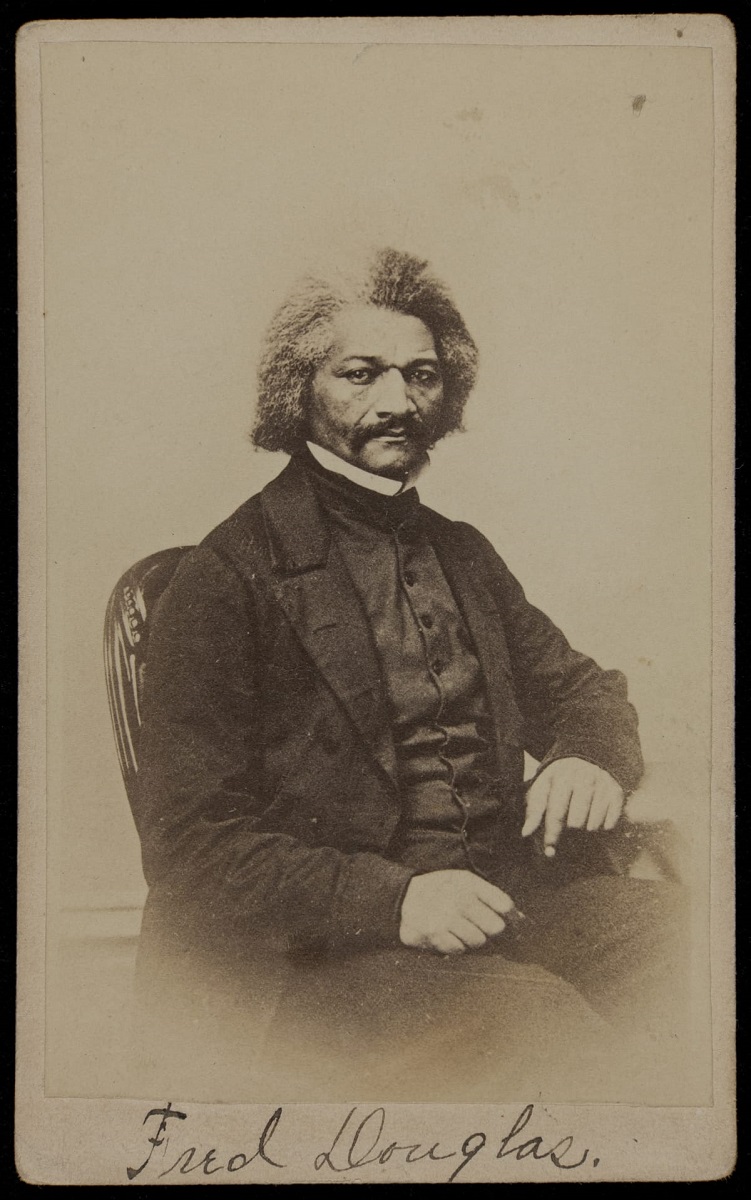
This portrait of Douglass was taken circa 1860, around the time Abraham Lincoln was elected the 16th president of the United States. / THF210623
Early Life & Escape
Born into slavery in Talbot County, Maryland, Frederick Douglass was named Frederick Augustus Washington Bailey by his enslaved mother, Harriet Bailey. Tragically, Douglass only saw his mother a few times before her early death, when Douglass was just seven years old. Though he had few memories of his mother, he recalled her fondly and was proud to learn that she also knew how to read. He wrote that he was “quite willing, and even happy, to attribute any love of letters I possess” to his mother. Few enslaved people could read at that time—Douglass’s pride in his mother was certainly justified.
In 1826, Douglass was sent to Baltimore, Maryland, to live with the family of Hugh and Sophia Auld—extended family of his master, Aaron Anthony. This move to Baltimore would be transformative for Douglass. It not only exposed Douglass to the wider world, but was also where Douglass learned to read.
Douglass was initially taught to read by Sophia Auld, who considered him a bright pupil. However, the lessons were put to a stop by Hugh Auld. It was not only illegal to teach an enslaved person to read, but Hugh also believed literacy would “ruin” Douglass as a slave. In a sense, Douglass agreed, as he came to understand the vast power of literacy. Douglass would later remark that “education and slavery are incompatible with each other.”
Douglass was determined to read. He “converted to teachers” some of the friendlier white children in the neighborhood. They showed him a school reader entitled The Columbian Orator, by Caleb Bingham, that he came to rely upon. In 1830, he purchased his own copy for 50 cents. The book—a collection of exceptional oration, poems, dialogue, and tips on the “art of eloquence”—became a great inspiration to Douglass. He carried it with him for many years to come.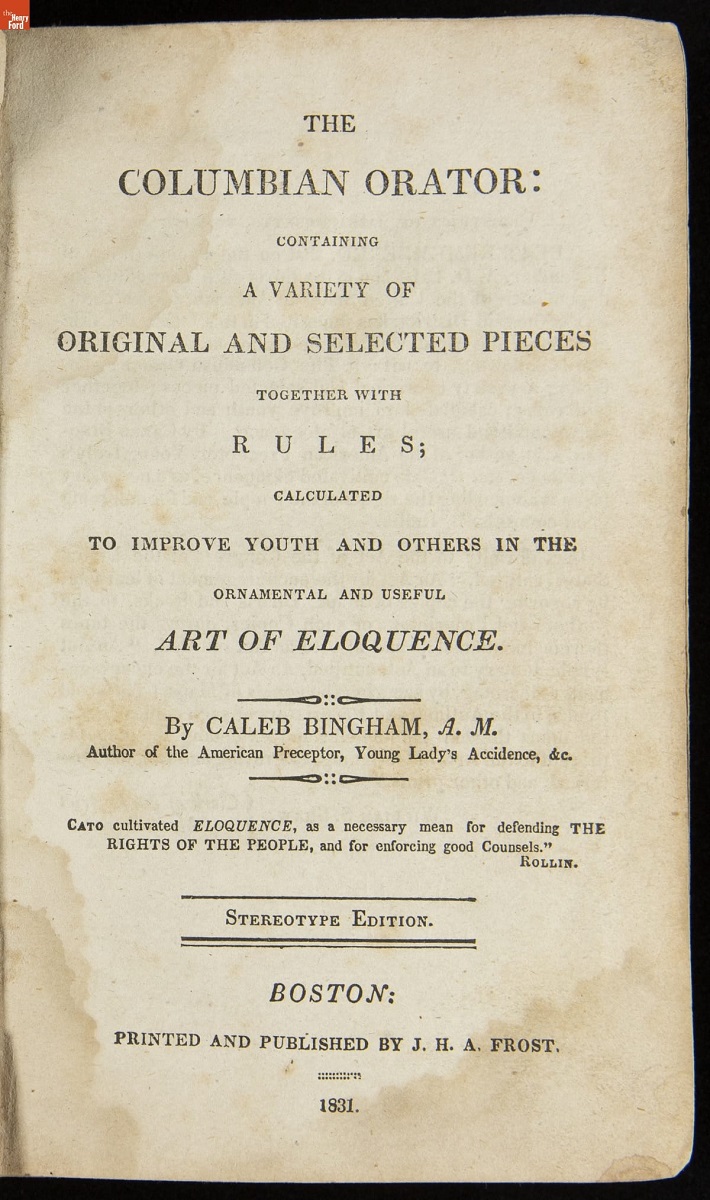
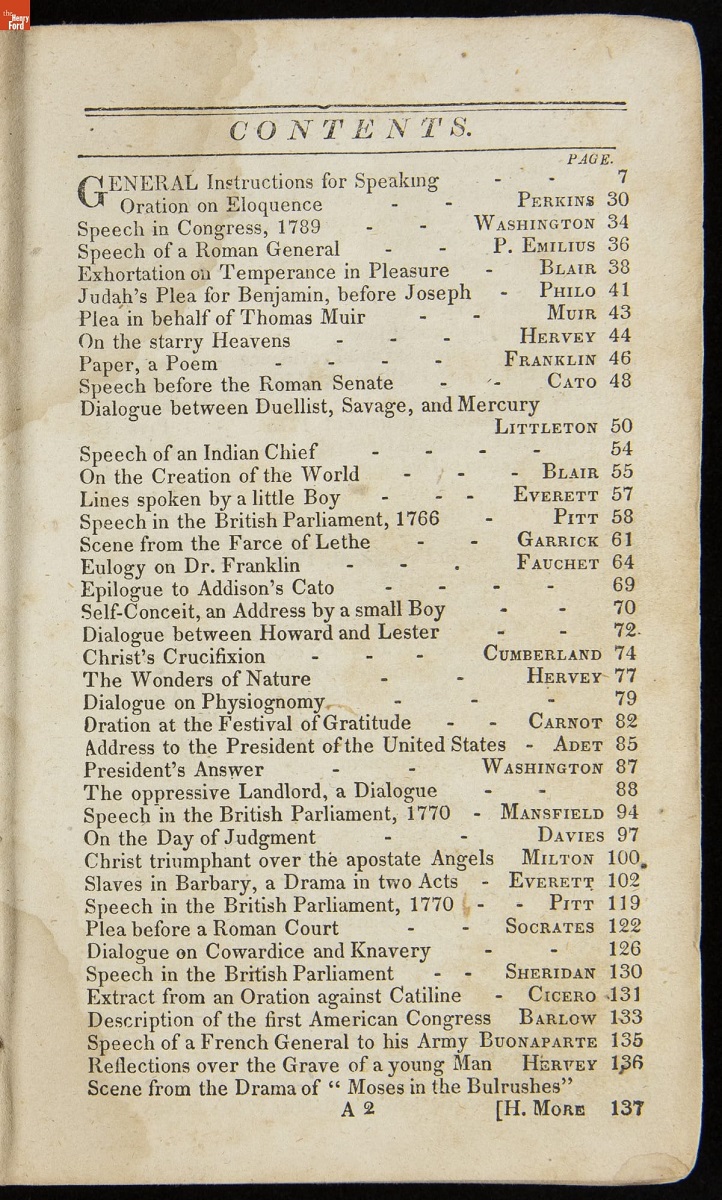
“The Columbian Orator” features a discussion between an enslaved person and their master which impressed Douglass. The enslaved person’s dialogue—referred to as “smart” by Douglass—resulted in the man’s unexpected emancipation. / THF621972, THF621973
As recollected in his first memoir, Narrative of the Life of Frederick Douglass, an American Slave, published in 1845, Douglass’s teenage years were some of his most challenging. He became viewed as a “troublemaker.” He was hired out to different farmers in the area, including one who had the reputation as an “effective slave breaker” and was especially cruel. Knowing that a larger world awaited and facing a terrible quality of life, Douglass attempted an escape in 1836. The escape failed and he was put in jail. Douglass was surprised to be released. He was sent not to the deep South as he had feared, but instead, back to Baltimore and the family of Hugh Auld, to learn the trade of caulking at the shipyards. While working there, Douglass was subjected to the animosities of his white coworkers, who beat him mercilessly—and were never arrested for it because a white witness would not testify and the word of a Black man was not admissible. He continuously dreamt of escape.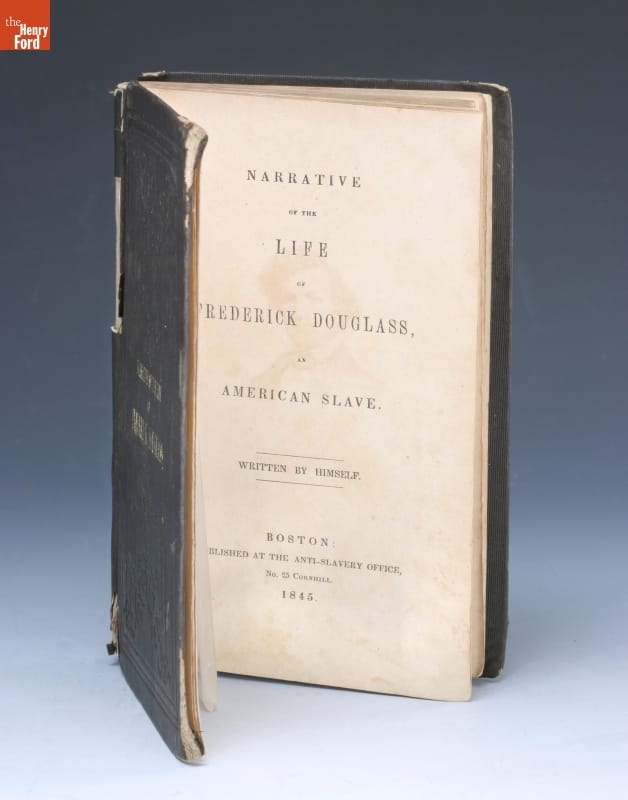
In this first memoir, Douglass provides great detail into his early life. However, because he was still a fugitive at the time of publication, he omitted details related to his escape. / THF8133
Recalling the ships on Chesapeake Bay, Douglass wrote:
“Those beautiful vessels, robed in purest white, so delightful to the eye of the freemen, were to me so many shrouded ghosts, to terrify and torment me with thoughts of my wretched condition. You are loosed from your moorings and are free; I am fast in my chains and am a slave! You move merrily before the gentle gale, and I sadly before the bloody whip!”
The ships’ freedom taunted him.
On September 3rd, 1838, Douglass courageously escaped slavery. Dressed as a sailor and using borrowed documents, he boarded a train, then a ferry, and yet another train to reach New York City—and freedom. His betrothed, Anna Murray Douglass, a free Black woman, followed, and soon after they were married. Frederick and Anna Murray Douglass moved to New Bedford, Massachusetts, with hopes that Frederick could find work as a caulker in the whaling port. Instead, he took on a variety of jobs—but, finally, the money he earned was fully his. It is believed that Anna Murray Douglass played a crucial role in supporting Frederick's escape. Their shared commitment to freedom made them a formidable team in the fight against slavery.
The American Anti-Slavery Society & the Abolitionists
While living in New Bedford, Douglass encountered William Lloyd Garrison’s abolitionist newspaper, The Liberator, for the first time. Douglass later wrote that the paper “took its place with me next to the Bible.” The Liberator introduced to Douglass the official abolitionist movement. This was a pivotal moment in his journey to becoming a prominent abolitionist leader.
In August of 1841, Douglass attended an abolitionist convention. In an impromptu speech, he regaled the audience with stories of his enslaved past. William Lloyd Garrison and other leading abolitionists noticed—Douglass’s career as an abolitionist orator had begun. Douglass became a frequent speaker at meetings of the American Anti-Slavery Society. His personal story of life enslaved humanized the abolitionist movement for many Northerners—and eventually, the world. His powerful speeches resonated deeply, inspiring many to join the cause.
In 1845, he published his first memoir, Narrative of the Life of Frederick Douglass, an American Slave. By 1847, it had already sold more than 11,000 copies! This would be followed by two more memoirs: My Bondage and Freedom in 1855 and Life and Times of Frederick Douglass in 1881. These narratives became essential texts in the abolitionist movement and the aftermath of the Civil War, providing firsthand accounts of the horrors of slavery.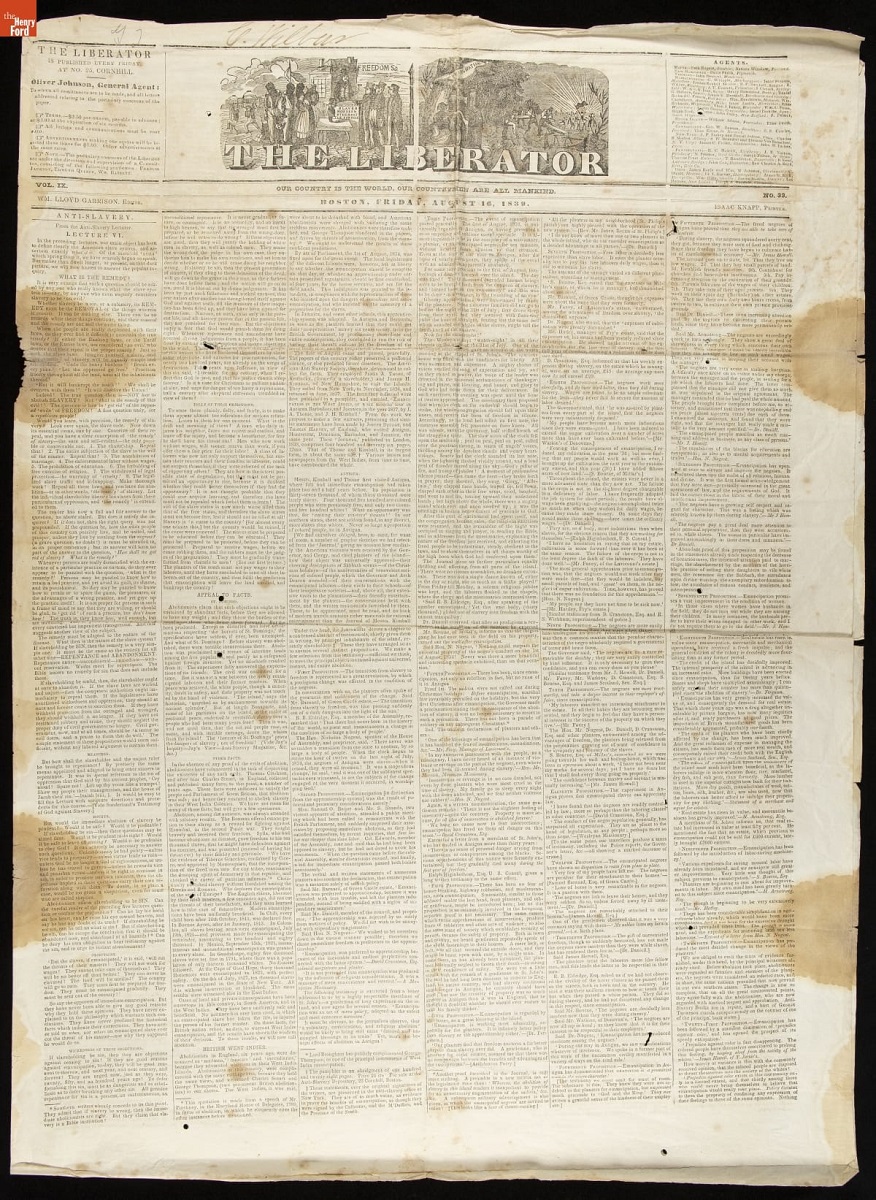
This copy of William Lloyd Garrison’s The Liberator was published on August 16, 1839—around the time when Douglass first encountered the paper. / THF621979
Women’s Suffrage
Douglass was also supportive of the women’s suffrage movement. He spoke at the famous Seneca Falls Convention of 1848 in support of women’s rights. In fact, the motto of his newspaper, The North Star, was “Right is of no sex—Truth is of no color—God is the Father of us all, and we are brethren.”
While Douglass forcefully supported women’s suffrage, some of his actions put him at odds with others in the movement. He supported the adoption of the 14th amendment, ratified in 1868, which guaranteed equality to all citizens—which included Black and white males, including the formerly enslaved. It did not include women. He also supported adoption of the 15th amendment, ratified in 1870, which secured Black males voting rights. Again, the amendment excluded women. Although a dedicated women’s rights activist, Douglass supported the adoption of the 14th and 15th amendments as he believed the matter to be “life or death” for Black people. This put him in disagreement with Elizabeth Cady Stanton and Susan B. Anthony, two of the leaders of the women’s suffrage movement, as well as his friends. Despite this disagreement about timing, Douglass would continue to lecture in support of women’s equality and suffrage until his death.
John Brown’s Raid
Douglass was well-acquainted with famous abolitionist leader John Brown, first meeting him in 1847 or 1848. Brown became known for leading a raid on the armory at Harpers Ferry, Virginia, in 1859, intending to create an “army of emancipation” to liberate enslaved people. Douglass and Brown spoke shortly before John Brown’s raid. Brown had hoped that Douglass would join him, but Douglass declined. He believed that Brown was “going into a perfect steel trap, and that once in he would not get out alive.”
Douglass was right. Brown was captured during the raid and was subsequently tried, convicted, and executed. Brown became seen as an anti-slavery martyr, as the below print shows. Henry David Thoreau remarked about him, “No man in America has ever stood up so persistently and effectively for the dignity of human nature…”
A letter from Douglass was found among John Brown’s belongings, leading to warrants for Douglass’s arrest as a conspirator. He was lecturing in Philadelphia at the time of the discovery. John Hurn, Philadelphia’s telegraph operator, was sympathetic to the abolitionist cause. He received a dispatch for the sheriff calling for Douglass’s arrest and both sent a warning to Douglass and delayed relaying the dispatch to the sheriff. Douglass fled and made it to Canada, narrowly escaping arrest. He then went abroad on a lecture tour, resisting apprehension in the States.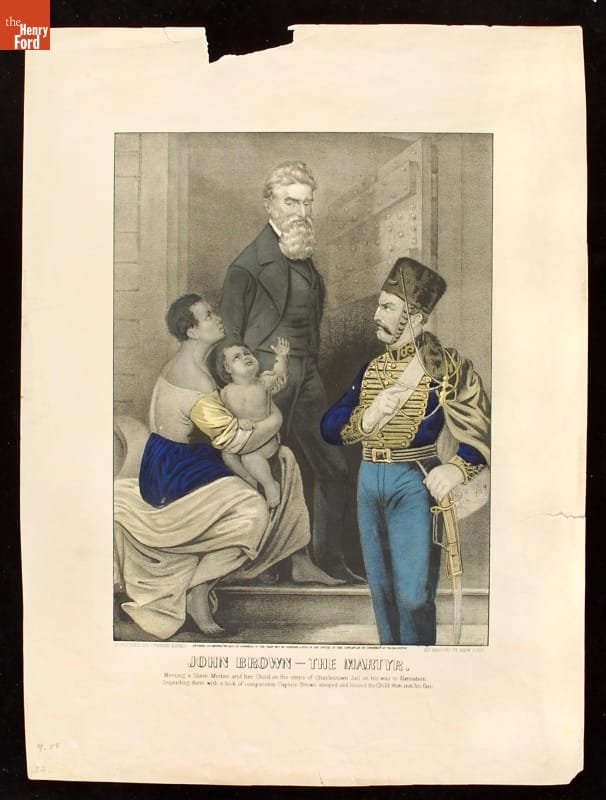
The text on this Currier & Ives print reads “John Brown—The Martyr: Meeting a Slave Mother and her Child on the steps of Charlestown Jail on his way to Execution. Regarding them with a look of compassion Captain Brown stooped and kissed the Child then met his fate." This did not actually occur, but became popular lore, as well as the subject of artwork and literature. / THF8053
The Civil War & Abraham Lincoln
In 1860, Abraham Lincoln was elected President of the United States. At the time, Douglass was not optimistic about the cause of abolition under Lincoln’s presidency. As tensions between the North and South grew and Civil War loomed, Douglass welcomed the impending war. As biographer David Blight states, “Douglas wanted the clarity of polarized conflict.”
Douglass got involved in the war effort through the recruitment of Black soldiers. Two of his sons, Charles and Lewis, joined the 54th Massachusetts Regiment, the second Black regiment in the Union Army. Douglass first met President Abraham Lincoln in August 1863, when he visited the White House to discuss grievances against Black troops. Even without an appointment and a room full of people waiting, Douglass was admitted to see Lincoln after just a few minutes.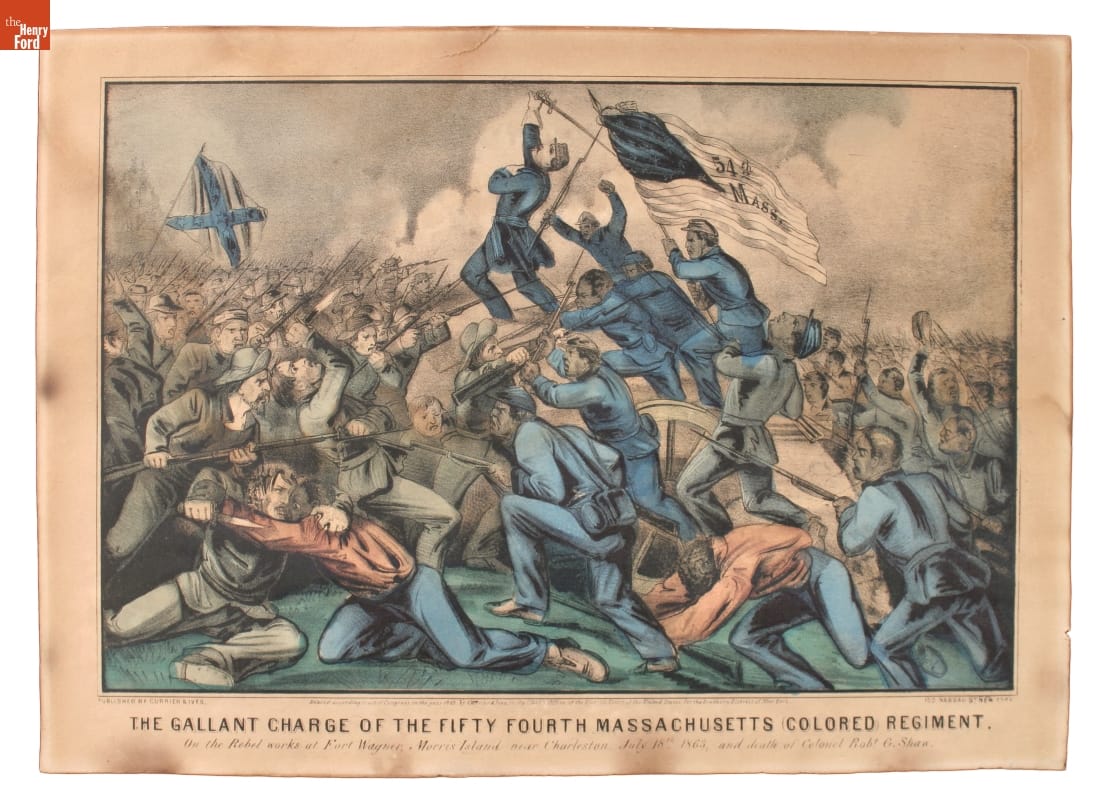
Two of Frederick Douglass’s sons, Lewis and Charles, fought with the 54th Massachusetts Colored Regiment. Lewis Douglass was appointed Sergeant Major, the highest rank that a Black person could then hold. / THF73704
Douglass would go on to advise Lincoln over the following years. After Lincoln’s second inaugural address, he asked Douglass his thoughts about it, adding, “There is no man in these United States whose opinion I value more than yours.”
On February 1, 1865, Lincoln approved the Joint Resolution of the United States Congress proposing the 13th Amendment to the Constitution—the “nail in the coffin” for the institution of slavery in the United States. But before the 13th Amendment could be ratified, Lincoln was assassinated by John Wilkes Booth on April 15, 1865. While Douglass and Lincoln certainly disagreed on many topics, Douglass remembered him fondly. In his eulogy, Douglass called Lincoln “the Black man’s president: the first to show any respect to their rights as men.”
After the Civil War and even after Reconstruction, Douglass held high-ranking government appointments—often becoming the first Black person to do so. Douglass was appointed the Minister Resident and Consul General to Haiti in 1889.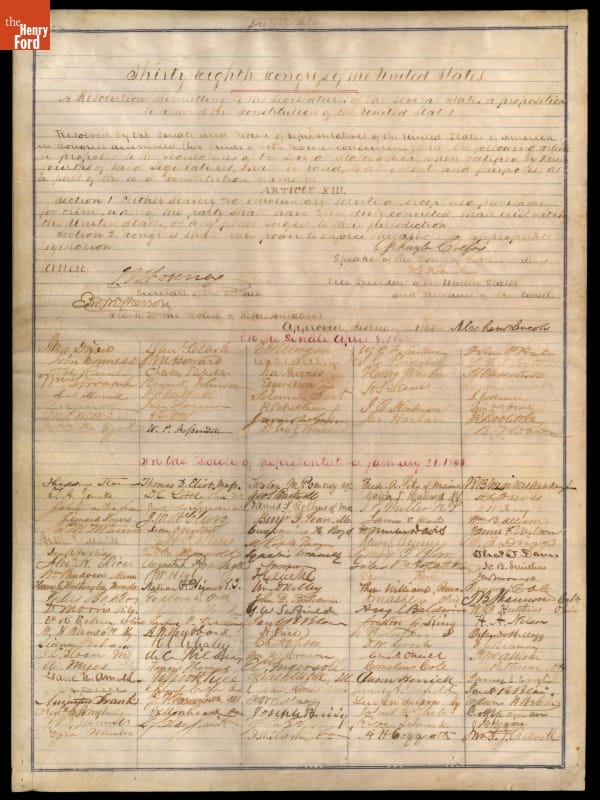
While Douglass certainly supported the 13th Amendment’s abolition of slavery, he did not think it went far enough. He remarked, “Slavery is not abolished until the black man has the ballot. While the legislatures of the south retain the right to pass laws making any discrimination between black and white, slavery still lives there.” / THF118475
Douglass continued to lecture in support of his two primary causes—racial equality and women’s suffrage—until the very end. On February 20, 1895, he attended a meeting of the National Council of Women, went home, and suffered a fatal heart attack. He was 77 years old.
Frederick Douglass remains one of the most inspirational figures in American history. We can still feel the weight of the words he wrote and spoke, more than 125 years after his passing. Douglass said, “Memory was given to man for some wise purpose. The past is … the mirror in which we may discern the dim outlines of the future and by which we may make it more symmetrical.” This work continues.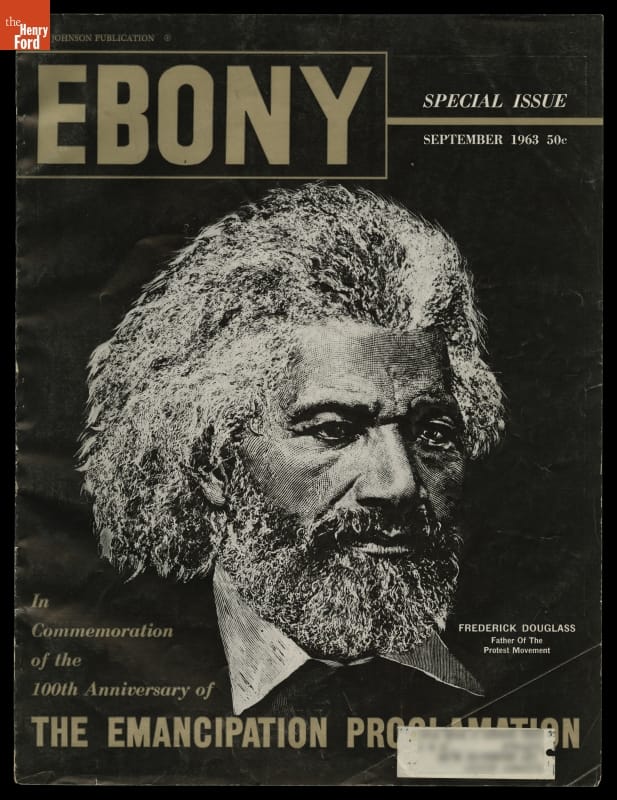
Frederick Douglass remains a powerful symbol of the fight for racial justice and equality. Here, his image graces the cover of Ebony Magazine’s issue celebrating the 100th anniversary of the Emancipation Proclamation. / THF98736_REDACTED
Katherine White is Associate Curator, Digital Content, at The Henry Ford. She appreciated the recently published book by David Blight, Frederick Douglass: Prophet of Freedom, as she conducted research for this post.
Maryland, women's history, voting, Massachusetts, education, Civil War, Civil Rights, by Katherine White, books, African American history, Abraham Lincoln, 19th century, #THFCuratorChat
Results by Radio: Election Day 1920

A crowd gathers outside the news office of the San Francisco Examiner to await the outcome of the 1920 presidential election. Reporters used loudspeakers to announce the results to the throng of voters and spectators. / THF610502
On Election Day, November 2, 1920, Americans waited anxiously for news of who would be the next President of the United States. In the evening, many voters milled around newspaper and government offices waiting to hear from election officials and reporters the latest results that were streaming across telephone and telegraph wires; others waited to read about the outcome in the next day's newspaper. But in 1920, a growing number of Americans could stay at home and listen to election returns announced over the expanding wireless media -- radio. During the next decades, radio would become an essential link in the political life of Americans -- not only for Election Day results, but for news of campaigns, conventions, and inaugurations; reports on the life of the President; and for the calm reassurance of leadership articulated in fireside chats.
Pittsburgh, Pennsylvania, radio station KDKA broadcast the election returns in between musical interludes to hundreds of listeners on Election Day. The station was the first federally licensed commercial radio station in America. This photograph shows the studio in 1920. / THF120670
Andy Stupperich is Associate Curator, Digital Content, at The Henry Ford.
20th century, 1920s, voting, radio, communication, by Andy Stupperich
The Automobile and Women’s Suffrage

In the years following the introduction of the automobile, women had few chances to challenge prevailing, gendered beliefs about their place behind the wheel. But where limited opportunities did exist, women seized them. They competed in organized races and reliability tours, volunteered for motor service during World War I, and drove to rally support for women’s suffrage.
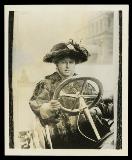 |
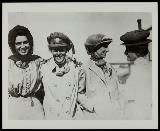 |

|
1910s, 20th century, women's history, voting, cars, by Saige Jedele
Women’s Suffrage Started with Women’s Rights

This 1867 music sheet (00.4.183) was dedicated to Elizabeth Cady Stanton, Susan B. Anthony, George Francis Train, Lucy Stone, and other “advocates of female suffrage.” / THF93144
We often hear the names of Elizabeth Cady Stanton and Susan B. Anthony in connection with the early struggle for “woman’s suffrage,” which we know more commonly today as “women’s suffrage”—the right of women as American citizens to vote. What is lesser known is that the early women’s suffrage movement began within the context of the broader struggle for women’s rights and it involved many more people—men as well as women, Black as well as white.
This scene of domestic bliss from an 1880 trade card (89.0.541.1270) for parlor stoves belies the fact that women at this time lacked basic rights. / THF224913
Women’s Rights, Denied
Into the early 20th century, women were not considered entities with rights separate from men. They could not vote, serve on a jury, testify in court, or hold public office. If married, it was illegal for women to sign contracts, inherit property, keep or invest their own earnings, have automatic rights to their children (even after a divorce or if their husband died), or make a will without their husband’s consent. It was very difficult for them to get divorced from an abusive husband or have a profession other than that centered around home and children. Furthermore, they were expected to stay out of public matters—centering their lives around family and home, obeying their husbands, and behaving at all times in a refined, polite way.
Abolitionist literature like The American Anti-Slavery Almanac for 1840 (2005.0.17.1), produced by and for northern abolitionists, often featured provocative covers depicting the brutality of slavery. / THF7209
Breaking Early Barriers
During the early 19th century, a few strong women began expressing their views about the rights of women as separate from men. Many of the early women who spoke out were white, educated, middle-class members of the Society of Friends, or Quakers. Members of this religious sect not only accepted women as equals to men but also saw it as their duty to seek justice for all. Lucretia Mott, one of the organizers of the 1848 Seneca Falls Convention, was Quaker. Susan B. Anthony, who joined the movement a bit later, also had a Quaker upbringing.
Many of these women had also long championed the abolition of slavery. In this they found allies in men as well as Black women. It was as advocates for this movement that these women got practice attending and speaking out at meetings. They paved the way for other women.
The title of this ca. 1851 oil painting (59.124.1) is “The Temperance Pledge,” referring to an important component of the temperance movement that involved signing a document in public promising to abstain from alcohol. / THF119917
Some of the early women’s rights advocates also championed temperance reforms—that is, an organized effort to encourage abstinence from, or at least moderation in, the consumption of intoxicating beverages—especially hard liquor. Excessive drunkenness, especially by men, was threatening the stability of many families (in 1830, consumption of alcohol was three times the current norm) and women led the charge to battle this. Elizabeth Cady Stanton and Susan B. Anthony were both temperance movement reformers before they became women’s rights advocates.
Elizabeth Cady Stanton was a leader in the struggle for women’s rights and an early advocate for women’s suffrage (98.94.18). / THF6584
A Few Voices Lead to Many
The Seneca Falls Convention of 1848 was the first official public forum for discussing women’s rights. But suffrage was never the main or the only goal there.
Lucretia Mott met Elizabeth Cady Stanton (who had recently married abolitionist Henry Stanton) at the World Anti-Slavery Convention in Great Britain in 1838, just as that country had ended slavery. They found they shared similar views and kept in touch after that. During a conversation when Mott visited Stanton’s hometown of Seneca Falls, New York, in 1848, Stanton’s feelings of oppression as a wife and mother came tumbling out. The two decided to call “a convention to discuss the social, civil, and religious conditions and rights of Woman.”
In July 1848, Mott, Cady Stanton and nearly 300 other attendees—men as well as women—gathered in Seneca Falls, including well-known self-emancipated orator and editor Frederick Douglass. James Mott, Lucretia’s husband, chaired the meeting, as women felt they lacked the experience as well as the knowledge of parliamentary procedure. Cady Stanton, possessing a gift for writing, had drafted a Declaration of Sentiments for the meeting, not unlike those presented and discussed at anti-slavery conventions at the time. But it was her genius to use the language and legitimacy of the Declaration of Independence, modifying the phrase “all men are created equal” to “all men and women are created equal.”
Self-emancipated abolitionist Frederick Douglass was an early champion for women’s suffrage (96.68.1). / THF210623
At the meeting, the attendees discussed the 18 grievances and 11 resolutions that Cady Stanton had drafted in her Declaration. But it was the resolution “that it is the duty of the women of this country to secure to themselves their sacred right to the elective franchise,” that led to the longest debate and greatest opposition. To most people at the meeting—women as well as men—the idea of women voting seemed far-fetched, ludicrous, even illogical. Cady Stanton defended it, claiming (what seems so obvious to us today) that women needed political rights to be able to make other gains through legal means. The resolution almost failed, until Frederick Douglass spoke fervently in its favor. It passed by a small margin—the only resolution adopted that was not unanimous.
Emancipated orator Sojourner Truth championed women’s rights along with abolition (96.72.1). / THF121160
The Seneca Falls Convention gave rise to numerous other women’s rights conventions that emerged over the next decade, in New York, Pennsylvania, Ohio, and Massachusetts. It was in Akron, Ohio, in 1851 that emancipated orator Sojourner Truth—best known for speaking out against slavery—gave her first known speech on women’s rights. She would continue to appear at many women’s rights conventions and give valiant service to the movement. It was also during this time that Susan B. Anthony assumed a leadership role in the women’s rights movement.
These conventions gave women practice in airing grievances, building consensus, and establishing alliances and friendships. Abolitionist support dominated these discussions, as the slavery issue heated up through the decade. There was no consensus about women’s suffrage. In fact, women’s suffrage was barely an issue on the table at convention after convention.
This 1867 cover of Harper's Weekly (2005.16.2) shows Black freedmen lining up to cast their ballots. Congress had recently approved measures allowing African Americans the right to vote—a right later ratified in the 15th Amendment. / THF11673
An Unfortunate Split
Only after the Civil War did women’s suffrage become the primary goal of the women’s rights movement. However, two factions split over how to achieve it. According to Angela P. Dodson in “Remember the Ladies”: Celebrating Those Who Fought for Freedom at the Ballot Box (2017), this “fissure” sundered alliances, strained relationships, diffused energies, squandered resources and stalled progress, and it took decades to heal.
The Revolution (2005.14.1), a newspaper distributed by the National Woman Suffrage Association (NWSA) and edited by Elizabeth Cady Stanton, featured essays supporting NWSA’s agenda. / THF277269
Although many women’s rights advocates supported the passage of the 13th Amendment formalizing emancipation, the dissension started with passage of the 14th Amendment (guaranteeing equality to all “male citizens”) and especially with the passage of the 15th Amendment (giving Black males the right to vote). In retrospect, it seems obvious that Black enfranchisement in the South was in peril if lawmakers didn’t act quickly and it was simply not judicious to fight for two difficult causes at the same time—Black freedmen’s rights and women’s rights. However, some women, including the vocal Elizabeth Cady Stanton, did not see it that way. These women felt they had fought long and hard for both abolition and women’s rights, and they felt they deserved their due.
It was at this time that women realized they needed to advocate for a national amendment calling for “universal suffrage” and began referring to themselves as suffragists. This would have been the perfect time for a national organization to push this agenda, and one was attempted at the 1866 National Woman’s Rights Convention, led by Susan B. Anthony. But there was almost immediately a division in the ranks—leading to two competing organizations. Stanton and Anthony formed the National Woman Suffrage Association (NWSA), working specifically for the enfranchisement of women and opposing the 15th Amendment. At the same time, women’s rights advocate Lucy Stone organized the American Woman Suffrage Association (AWSA) in support of the 15th Amendment and working toward a broader coalition (her group ultimately received more support). These two groups competed for allies and support for the next 25 years, weakening each other’s success and forcing each of them to work harder for state-by-state support rather than working together to fight for a federal amendment.
During the struggle for women’s suffrage, many men and some women strongly opposed the notion of women voting, as evidenced by this ca. 1910 button (2004.117.1). / THF8518
In 1869 and 1870, respectively, the Wyoming and Utah territories granted women the right to vote (primarily to attract settlers), while an amendment granting women the right to vote was finally brought to Congress beginning in 1878. But none of these actions engendered wider support, and many people (both men and women) continued to oppose women’s suffrage on many fronts.
During the early 20th century, suffragists often appealed to potential voters by distributing items with symbolic imagery, such as this ca. 1910 button (2004.116.1). / THF155862
A New Generation Takes Charge
It would take a new generation of women, lacking the painful memories of the reason for the rift in the first place, to take up the fight. These women reunified the group by forming the National American Woman Suffrage Association in 1890 (NAWSA) and creating new strategies for state and national support. This was also a time for Black women—who had played a modest role in the previous organizations—to form their own organizations that could champion women’s rights and women's suffrage, including the National Association of Colored Women in 1895 and the National Association for the Advancement of Colored People (NAACP) in 1909. Prominent leaders like Ida Wells-Barnett and Mary Church Terrell arose to lead other Black women in support of these causes. Unfortunately, white suffragists did not always welcome their help—in fact, some were willing to sacrifice this support to pacify Southerners and court their support for the ballot.
Alice Paul’s extremist tactics included aiming strong messages directly at President Wilson, as seen in this small handheld flag (2005.3.1) from about 1916. / THF8533
Two different kinds of leaders emerged during the early 1900s, for the final push to the 19th Amendment—Carrie Chapman Catt, the lobbyist, and Alice Paul, the agitator. Catt and Paul strongly disagreed with each other’s tactics, but neither would have succeeded without the other. Their different strategies offered women from all walks of life a way to get involved—organizing parades, printing flyers, and getting people to sign petitions. Victory was not easy to achieve, but on August 26, 1920—72 years after the Seneca Falls meeting—the 19th Amendment granting women the right to vote was added to the Constitution.
During the Jim Crow era, most southern states had adopted poll taxes to keep Blacks from voting. The person who wore this button (2005.9.8) protested the injustice of paying to vote, which was finally abolished with the passage of the 24th Amendment to the U. S. Constitution (1964) and subsequent court rulings (1966). / THF 96541
The Struggle Continues
Unfortunately, the 19th Amendment did not guarantee equal voting rights to women. Racist laws and practices kept African American women as well as women of other disenfranchised groups—including Latinx, Indigenous, and Asian American women—from voting for decades. Voter suppression is, in fact, still an ongoing issue today.
The Equal Rights Amendment (E.R.A.) finally passed both houses of Congress in 1972, but it was not ratified in enough state legislatures for approval (2001.76.1). / THF153507
Returning full circle to the larger issue of women’s rights, an Equal Rights Amendment was drafted in 1923—only three years after the 19th Amendment was ratified. Although it received much attention in the 1970s and early 1980s, it has never passed.
The struggle for women’s rights, including women’s right to vote, continues today.
Donna R. Braden is Senior Curator and Curator of Public Life at The Henry Ford.
20th century, 19th century, women's history, voting, by Donna R. Braden, African American history
Remember Your Candidate at the Ballot Box

If you live in the United States, you’ve probably noticed it is (and has been) presidential campaign season. Candidates go to great lengths to make themselves into household names, with the hope that when November rolls around, you will cast your vote in their favor. The Henry Ford holds a variety of material related to American presidential campaigns from the very beginning of our country through the last election cycle. We’ve recently digitized a number of artifacts demonstrating the unexpected places you might find political promotions, such as this package of “I Like Ike” cigarettes from the 1950s. Browse more items related to presidential campaigns by visiting our Digital Collections—don’t miss the William McKinley soap doll and the Richard Nixon gumball.
Ellice Engdahl is Digital Collections & Content Manager at The Henry Ford.
Conserving Our Political Paper Lanterns

The Henry Ford holds an extensive collection of late 19th century political campaign lanterns, dating from the 1860 to 1900. These paper, accordion-folded lanterns usually held candles and were used in processions and rallies in support of the candidates. They are screen printed in patriotic colors - some contain images of the candidates and/or slogans. In an age before television and radio, processions were a method of attracting attention for a political race. As paper objects these are truly ephemeral objects. Their survival for more than 100 years is remarkable. Continue Reading
The Henry Ford has hundreds of items in its collections related to American political campaigns, from 19th century examples to much more recent material (see this and/or this, depending on your personal political leanings). Earlier this year, we digitized some of our paper lanterns, and we’ve just added a number of our campaign buttons. This one shows support for Theodore Roosevelt and Charles Fairbanks in the presidential campaign of 1904. View close to 200 examples from our political campaign collections, including the recently added buttons, on our collections website.
Ellice Engdahl is Digital Collections & Content Manager at The Henry Ford.


